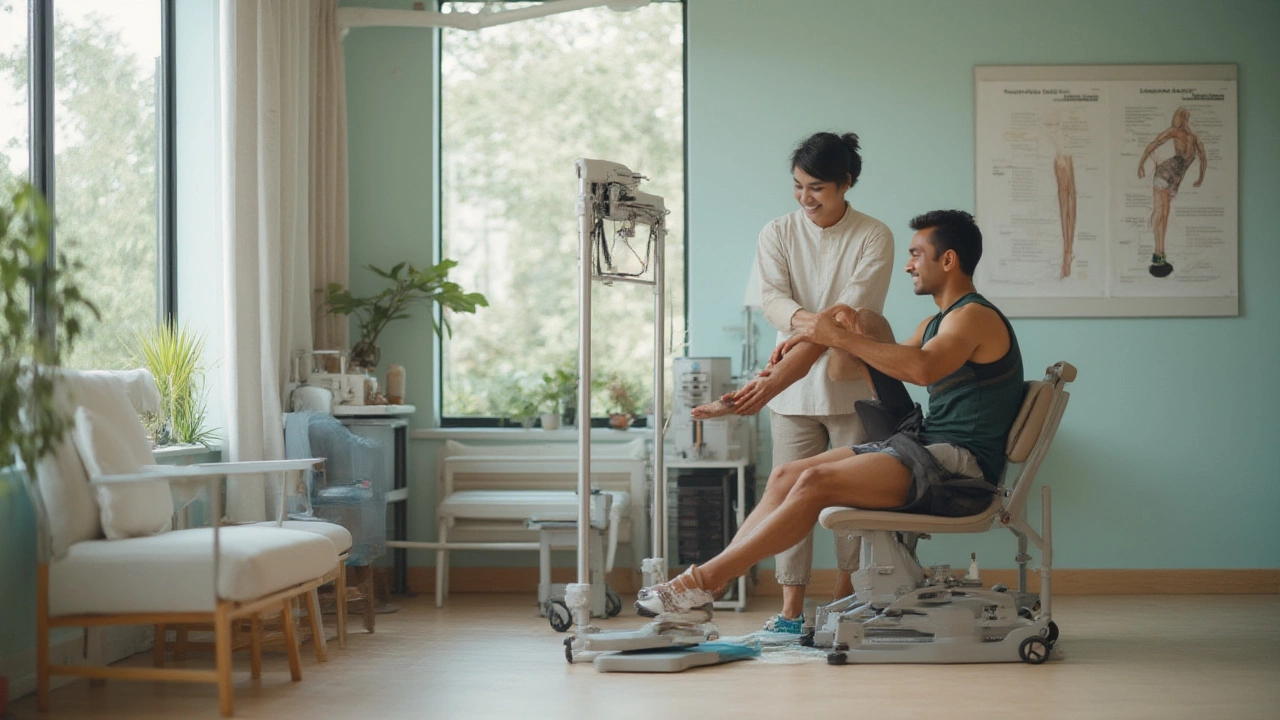Ever heard someone say knee replacement recovery is just a matter of "taking it easy?" That’s a myth plenty of folks with worn-out knees fall for. Plenty also believe you’ll be stuck in bed for weeks, unable to walk or look after yourself. The truth is a bit more surprising, and, honestly, way more hopeful. If you’re the kind of person who checks the dates on the calendar and wonders how quickly you’ll be back to your chai runs or those weekend market strolls in Pune, there’s good news ahead. Let’s break down the facts, tackle the myths, and get into what doctors, real patients, and science say about the days of rest you actually need after knee replacement surgery.
Understanding Knee Replacement Recovery: What Happens After Surgery?
Knee replacement surgery isn’t the terrifying, high-risk procedure people feared in the past. Modern medical advances—especially here in cities with top hospitals—have trimmed hospital stays and recovery times. After the operation, most patients wake up with their leg in a special bandage and sometimes an ice pack on the knee. The first few hours are all about monitoring—you’re groggy, your leg is supported, and nurses keep checking your pulse, blood pressure, and surgical wound. Actual rest, though, starts the next day. It’s not the long, strict bedrest old-timers warn you about. In fact, you’ll likely be encouraged to move pretty much within 24 hours. Surprised?”
Now here’s a stat to keep in mind: Most Indian hospitals discharge patients within 3 to 5 days post-operation, according to a 2023 report from the Indian Journal of Orthopaedics. Why so fast? Today’s pain relief methods and surgical techniques actually let you start light movement in the first day or two. You’ll initially need rest—true—but it looks different than a week lounging in bed. Instead, recovery sticks to a careful balance: rest punctuated by gentle activity. The first three days, you’ll spend a lot of time lying down, icing, occasionally flexing your ankle and toes, and getting used to your new knee.
By day two or three, a physiotherapist will visit. You’ll swing your legs over the edge of the bed with support, practice standing, maybe even do a few steps with a walker. Constant supervision stops you from overdoing it, but you’re not stuck under the covers. The pattern is: rest whenever you feel tired, but don’t skip the guided movement. Nurses and family members don’t usually let you “overdo it.” Short naps, stretching, and daily wound checks are routine. During these first five days, most people average around 16-18 hours of rest/lying down per day, including sleep.
By the end of the first week, patients—unless there are major complications—are encouraged to continue physiotherapy at home, with short, frequent rest intervals. So, the idea of “days of rest” after knee replacement is about getting the right type and dose of rest, not treating yourself like a fragile porcelain figure.
How Many Days of Rest is Actually Needed? Breaking Down Recovery Stages
The golden question: how many days of rest is required after knee replacement? The answer isn’t a perfect number for everyone. Recovery is personal. But there are some scientific timelines that doctors stick to for a reason. Here’s what usually happens for typical knee replacement patients—barring unusual risk factors.
Let’s start with a simple recovery table for average, healthy adults after a primary, non-complicated knee replacement in India:
| Days After Surgery | Rest Needed (Per Day) | Physical Activity Allowed | Notes |
|---|---|---|---|
| Day 1-3 | 16-18 hours | None to minimal (ankle/toe wiggles) | Nursing care, pain control |
| Day 4-7 | 12-15 hours | Easy standing, short assisted walks | Physio starts, monitor wound |
| Week 2 | 10-12 hours | Longer walks, gentle knee bends | Homely rest with exercise |
| Week 3-4 | 8-10 hours | Stairs (with support), gradual increase | Stitches removal, build confidence |
| 1 Month+ | 8 hours (normal sleep) | Resume most normal activities | Review by surgeon |
These numbers are averages. The first week is about protecting your knee, avoiding falls, and helping the body adjust. Too much rest (simply lying flat without movement) slows recovery—muscles get weaker, circulation dips. Too little, and you could risk swelling or even displacing the new joint. That’s why doctors adjust rest based on age, other health conditions (like diabetes or hypertension), weight, and even motivation level.
Here’s a fresher angle: a few studies in Pune, including one from Deenanath Mangeshkar Hospital in 2024, tracked knee replacement patients. They found that those who mixed careful rest with early, supervised movement returned to independent walking about 6 days sooner than those who rested longer without moving much. Their pain scores were also lower—and fewer people developed complications like blood clots.
After the first month, formal “rest” isn’t needed more than what your body asks for. Normal life—walking to the bathroom, preparing simple meals, sitting in a chair—should feel possible by week 2 or 3 for most patients. Special exceptions exist, of course. Some folks over 75, or those with previous joint surgeries, might need an extra week or two. But the fear that you’ll be housebound for months just isn’t borne out by science. Dr. Anuj Kumar, an orthopedic specialist in Pune, told the Times of India in 2024:
“We rarely recommend more than seven to ten days of pronounced rest. Beyond that, physiotherapy and daily routine are actually good medicine.”

What Makes Recovery Faster or Slower? Key Factors After Knee Replacement
Not every recovery is a direct flight—sometimes there are layovers. The biggest influences? Age, pre-existing medical conditions, weight, and—let’s be honest—attitude. Patients in their late 60s or early 70s, especially those used to walking daily before operation, usually bounce back faster. People with extra weight, diabetes, or chronic issues may face more swelling and fatigue, which delays their ability to cut down on rest days.
Smoking also matters. Nicotine slows healing. A multicenter Indian study in 2022 discovered smokers required up to 40% more rest days due to slower wound healing and higher risk of infection. Nutrition comes next—as your appetite bounces back, focus on protein-rich foods (paneer, dal, eggs if permitted), vitamin C (amla, oranges) and plenty of fluids. Hydration and good food literally fuel your body’s repair crew.
Pain management matters more than most people realize. Without enough relief, you’ll shy away from movement—even small acts, like getting out of bed. Most doctors use a cocktail of painkillers, sometimes with local anesthesia blocks, to keep discomfort manageable in the first ten days. If you’re hurting more than expected, always mention it to your team. Ignoring pain just makes you rest longer and move less.
Physiotherapy is the magic ingredient. Skipping those first sessions, or not following instructions, can set your progress back. You’ll start slow—maybe even just learning to tighten your thigh muscle or flex your ankle while lying down. Each week, exercises get a notch harder, geared at improving knee flexibility and muscle strength. Home-based physio often works well, as long as someone experienced supervises the sessions. And here’s a good tip: don’t compare your journey to any neighbor’s. Two people having surgery on the same day may recover at wildly different speeds for reasons you’ll never see.
Don’t ignore emotional recovery. Studies from Pune’s Jehangir Hospital show that people with a positive attitude, regular visitors, and a good night’s sleep consistently felt less pain and were more eager for movement. If you’re anxious, talking openly to your doctor, friends, or family about concerns makes a real difference.
Tips and Tricks: Making Rest Work for You (Not Against You)
Most people make two mistakes: they either rest too much or push themselves too hard. Here’s what actually works for getting “just right” rest after knee replacement.
- Set a timer: Use your phone to remind yourself to change position every 45-60 minutes. Even just wiggling feet or flexing your quad wakes up muscles.
- Prioritize nighttime sleep: The most effective recovery happens when you get at least seven hours of uninterrupted sleep. If pain affects this, ask about better pain control at night.
- Use supportive pillows: A rolled towel under the ankle (not the knee) encourages gentle knee straightening, speeding up extension recovery. Don’t keep a pillow under the knee for long hours.
- Ice smartly: Twenty minutes on, twenty minutes off. This works wonders for pain and swelling, but don’t fall asleep with ice packs on skin—it can cause frostbite.
- Monitor swelling: Rest is essential if your leg feels hot, red, or extremely swollen. In such cases, elevate your leg on cushions above heart level for at least 30 minutes, three to four times a day.
- Get practical help: Arrange meals or light cleaning help for the first week at home. That way, you can rest without worrying about chores piling up.
- Share your goals: Telling your recovery goals to family or a friend makes you more likely to stick to them—resting when you should and moving when guided.
- Don't hurry back to driving: Plan for at least 4 to 6 weeks before driving, especially if your left knee (for most cars in India) was replaced.
- Watch for warning signs: Sudden fever, worsening wound pain, new redness, or calf swelling = call your doctor, even if you feel like you’re resting a lot.
- Bookmark your milestones: Keep a simple recovery journal, noting each day’s activity and rest. Looking back helps if you feel frustrated or stuck.
And yes, you can (and should!) sit on the floor again someday—just not in the first two or three months post-surgery. Take it slow, trust your body, and celebrate those small wins.





